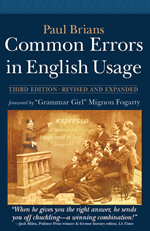In many European languages family names are often preceded by a preposition (de, da, di, von, and van all mean “of”), an article (le and la mean “the”) or both (du, des, del, de la, della and van der all mean “of the”). Such prefixes often originated as designators of nobility—or pretensions to it—but today they are just incidental parts of certain names.
In their original languages the two parts of the name are usually separated by a space, and the prefixed preposition or article is not capitalized unless it begins a sentence. If you take a college course involving famous European names you will be expected to follow this pattern. It’s not “De Beauvoir” but “de Beauvoir”; not “Van Gogh” but “van Gogh.” The only exception is when the name begins a sentence: “De Gaulle led the Free French,” but “Charles de Gaulle had a big nose.”
Some European names evolved into one-word spellings early on (Dupont, Lamartine, Dallapiccola), but they are not likely to cause problems because English speakers are usually unaware of the signficance of their initial syllables.
When families bearing prefixed names move to the US, they often adapt their spelling to a one-word form. A well-known example is “DiCaprio.” French le Blanc becomes LeBlanc in America, and Italian di Franco becomes DiFranco. The name “de Vries” is spelled in English by various people bearing that name “De Vries,” “DeVries,” and “Devries.” You have to check carefully to determine how a particular person prefers the name to be spelled. Library reference tools like Who’s Who are more reliable than most Web sources.
The practice of retaining the capital letter inside the fused form is one peculiar to American English. Early books by famed science-fiction author Ursula K. Le Guin rendered her name “LeGuin” though later reprints go with the separated form, which we may assume is her preference. The fused form has the advantage of being easier for computers to sort into alphabetized lists. You will find many Web pages in which the names of Europeans are adapted to the one-word form, but this is a sign of a lack of sophistication.
Once you learn to properly separate the parts of a last name, you need to know how to alphabetize it. Put van Gogh under V, but Van Morrison under M (“Van” is his given name, not part of his family name). Ludwig van Beethoven, however, is under B, not V.
College students also need to know that most Medieval and many Renaissance names consist of a single given name linked to a place name to indicate where the person came from. Marie de France means simply “Marie of France,” and she should never be referred to as simply “de France.” After introducing her full name, refer to her as “Marie.” Forget The Da Vinci Code; scholars refer to him as “Leonardo,” never as “da Vinci.”
BUY THE BOOK!
